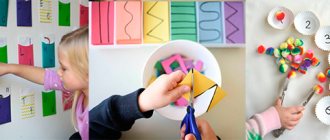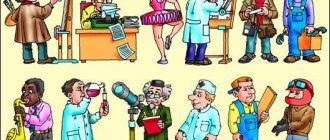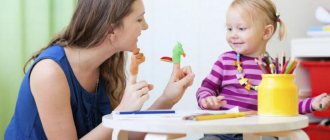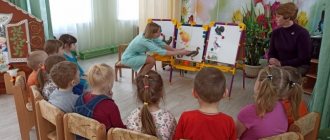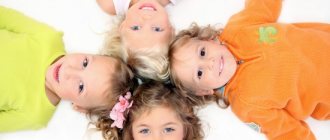Purity of speech affects future success at school and the process of social adaptation. Logorhythmics for children 2-3 years old is recognized throughout the world as a universal method for improving speech skills.
Logorhythmics is based on a set of exercises to improve articulation and breathing, physical fitness, and sense of rhythm. As a result of classes, both the ability to navigate the huge world around us and the understanding of the meaning and order of completing the proposed tasks increase. The little person begins to show himself as a creative person.
What it is
In preschool educational institutions, logorhythmics for toddlers and children 2-3 years old is used as one of the means of correctional pedagogy. An integrated technique, the name of which consists of two words – speech therapy and rhythmics, is necessary to improve speech, develop musical ear and coordination.
The method is successfully used by Russian specialists in correctional pedagogy; Ekaterina Zheleznova played a special role in its popularization. A full range of classes using different types of games and training includes:
- walking with a change of direction;
- breathing exercises;
- gymnastics that improves muscle tone;
- articulation of poetry;
- singing.
At each lesson, the child encounters music, words and movement, regular training accustoms him to a routine, they have a beneficial effect on the formation of the musculoskeletal, speech and other systems of the body.
We develop speech, voice, memory using proven logorhythmic methods.
Contained in sections:
- The work of a speech therapist. Speech therapy 8118
By groups:
- Senior group
- Preparatory group
- Middle group
- Junior group
Showing publications 1-10 of 1423. All sections | Logorhythmics. Logorhythmic exercises
New
Photo
The best
Summary of logorhythmic gcd in the middle group “Visiting grandma”
Summary of direct educational activities in the middle group “Visiting grandma”
Logorhythmic lesson Musical director together with a speech therapist Speech therapist : Naumova M.A. Musical director: Klimkova Zh. Yu. Yaroslavl 2021 Goal: Update and...
Logorhythmic lesson “Journey to a fairy tale” in junior group of preschool educational institution Synopsis of the logorhythmic lesson “Journey to a Fairy Tale”
in the junior group of preschool educational institutions. Objectives: Educational: -develop spatial understanding; -develop switchability and coordination of movements; -develop rhythmic expressiveness; -develop imagination and...
What kids can't do without logorhythmics?
Parents are not always ready to admit the need for correctional pedagogy for their heirs; they develop at different speeds, and what is available to one at 2 years old, the second will master at 3. Individuality predetermines the education system. But in child development up to 2-3 years, logorhythmics will be inevitable if the baby:
- stutters;
- cannot cope with a normal speech rate;
- has dysarthria or has been diagnosed with mental retardation;
- poorly oriented in space;
- does not learn motor skills very quickly.
Note! Regular music and singing lessons, games, movement will quickly solve problems with a temporary slowdown in understanding the world around you and feeling yourself in it, tighten up and improve physical fitness
Logorhythmics for children 2-3 years old
At an early stage of development, the educational institution will take over the organization of training. The game form and the company of other students helping each other will accelerate the acquisition of speech skills. But parents should not completely shift responsibility to teachers, so as not to lose momentum and consolidate the achieved results. Games and exercises will not take much time and will bring joy to the whole family. The system is designed to achieve such goals as:
- training of speech skills or their correction;
- improvement of the body;
- breathing development;
- improving coordination;
- aesthetic education;
- improved sense of rhythm.
In home exercises, a set of basic exercises will be easy for the family, games and tongue twisters are easy to learn and repeat. The two most popular lesson series are based on familiar images of plants and animals, they will increase engagement in the process and make each lesson not only useful, but also entertaining.
At home, you can choose the time and songs and poems you like best, and tune in to your baby’s internal rhythms. For older people, breathing exercises and finger exercises are added. Classes should be held 2 times a week, closer to the evening. Parents will have to take time to prepare.
Vegetables and fruits
Fauna and flora are traditionally used in teaching. Exercises and rules for how to work with a child are offered in manuals and video lessons. They are based on imitation of actions that occur in the process of interaction with plants that come from the garden.
The baby, following his parents, repeats poems and performs steps, gestures, squats, and dance elements. Various tasks are offered. For example, during “pickling cabbage,” the baby reads the text and performs movements that imitate picking and chopping a head of cabbage, rubbing carrots, mixing and salting.
When traveling to a garden or farm, visual images of the gifts of nature are used, the teacher talks about how fruits, berries, and root vegetables grow. Next, the parent or teacher repeats movements imitating picking fruit. It is allowed to hide similar toys in the room. Each action is accompanied by an articulate pronunciation of the text.
Animals
A journey into the world of fauna combines poetry and imitative movements. The guys dance, holding their hands on their belts, like beetles, pulling their hands up, stomping. Having met a bear, they begin to clubfoot and walk, swaying from one foot to the other. Imitating a hare, they begin to stretch out their ears or crouch.
Exercises are most effective in a group when children see each other's movements. But at home, parents can become a clear example by learning poems and movements in advance using video lessons. The complex is fast and energetic, well develops motor skills and the ability to navigate in space and interact in a group.
Logorhythmics by Ekaterina Zheleznova for children 2-3 years old
Music will become an essential part of training if you use a specially designed complex. The system of correctional pedagogy was developed by many domestic scientists, but Zheleznova’s logorhythmics for children 2-3 years old is especially popular among parents.
It includes musical accompaniment; it is necessary to use backing tracks; an additional result of using the technique will be the development of phonetic hearing. Simple songs about a bus, a bear, or a spider are constructed in such a way as to maximize the training of the muscles responsible for articulation.
The complex will be most useful for the age group up to four years old; at this stage of life, hearing and a penchant for music are well formed. Zheleznova’s speech therapy logorhythmics for children 2-3 years old will be a universal way to harmonize a child’s personality and help him grow spiritually, but it should not become the only method.
Additional training and games, such as “Postman” or “Wind and Trees,” will introduce the little person to the people and phenomena of the world around him. They also combine a complex of poems and movements.
Systematic use of logorhythmics, combination of activities with teachers and parents, monitoring and correction of results will quickly affect the development of the baby and the quality of his speech. The successes he achieves will bring joy to his parents, stimulating them to continue their studies.
How to write a term paper on speech therapy
07.09.2010 230130
These guidelines are compiled to help students gain an understanding of the content and structure of coursework in speech therapy.
Logopedia of pedagogical science that studies anomalies of speech development with normal hearing, explores the manifestations, nature and mechanisms of speech disorders, develops the scientific basis for overcoming and preventing them means of special training and education.
The subject of speech therapy as a science is speech disorders and the process of training and education of persons with speech disorders.
The object of study is a person suffering from a speech disorder.
The main task of speech therapy as a science is the study, prevention and elimination of various types of speech disorders.
Coursework in speech therapy is a student's scientific and experimental research. This type of educational activity, provided for by the educational and professional program and curriculum, contributes to the acquisition of skills in working with literature, analyzing and summarizing literary sources in order to determine the range of insufficiently studied problems, determining the content and methods of experimental research, processing skills and qualitative analysis of the results obtained. The need to complete coursework in speech therapy is due to the updating of knowledge concerning the content, organization, principles, methods and techniques of speech therapy work.
As a rule, during their studies, students must write two term papers - theoretical and practical.
The first course work should be devoted to the analysis and synthesis of general and specialized literature on the chosen topic. Based on this analysis, it is necessary to justify and develop a method of ascertaining (diagnostic) experiment.
In the second course work, it is necessary to provide an analysis of the results obtained during the ascertaining experiment, as well as determine the directions and content of speech therapy work, and select adequate methods and techniques of correction.
So, let’s present the general requirements for the content and design of coursework in speech therapy.
The initial and most important stage of working on a course project is the choice of a topic, which is either proposed by the supervisor or chosen by the student independently from a list of topics that are consistent with the areas of scientific research of the department.
Each topic can be modified, considered in different aspects, but taking into account a theoretical and practical approach. Having chosen a topic, the student needs to think through in detail its specific content, areas of work, practical material, etc., which should be reflected both in the formulation of the topic and in the further construction of the study. It should be recalled that the chosen topic may not only have a purely theoretical orientation, for example: “Dysarthria. Characteristics of the defect”, “Classification of dysgraphia”, but also take into account the practical significance of the problem under consideration, for example: “Speech therapy work on speech correction for dysarthria”. It should also be taken into account that when formulating a topic, excessive detail should be avoided, for example: “Formation of prosodic components of speech in preschoolers of the sixth year of life attending a preschool institution for children with severe speech impairments.”
The course work includes such mandatory parts as: introduction, three chapters, conclusion, bibliography and appendix.
The text of the term paper begins with the title page . An example of its design can be seen here.
Then the content of the work is given, in which the names of chapters, paragraphs, and sections are formulated in strict accordance with the content of the thesis. An example of its design can be seen here.
In the text, each subsequent chapter and paragraph begins on a new page. At the end of each chapter, the materials are summarized and conclusions are formulated.
The introduction reveals the relevance of the problem under consideration in general and the topic being studied in particular; the problem, subject, object, and purpose of the study are defined. In accordance with the goal and hypothesis, objectives and a set of research methods aimed at achieving the objectives must be defined.
The relevance of the topic lies in reflecting the current level of pedagogical science and practice, meeting the requirements of novelty and usefulness.
When defining the research problem, it is important to indicate what practical tasks it will help to implement in training and educating people with speech pathology.
The object of research is understood as certain aspects of pedagogical reality, perceived through a system of theoretical and practical knowledge. The ultimate goal of any research is to improve this object.
The subject of research is some part, property, element of an object, i.e. the subject of research always indicates a specific aspect of the object that is to be studied and about which the researcher wants to gain new knowledge. An object is a part of an object.
You can give an example of the formulation of the object, subject and problem of research:
– The object of the study is the speech activity of preschool children with phonetic-phonemic speech disorders.
– The subject of the study is the features of intonation speech of children with phonetic-phonemic speech disorders.
– The research problem is to determine effective directions for speech therapy work on the formation of intonation expressiveness of speech in the system of correctional intervention.
The purpose of the study contributes to the specification of the object being studied. The goal of any research is to solve a specific problem. The goal is specified in tasks taking into account the subject of research.
The research objectives are formulated in a certain sequence, which determines the logic of the research. The research objectives are set on the basis of a theoretical analysis of the problem and an assessment of the state of its solution in practice.
The first chapter is an analysis of literary sources, which examines the state of this problem in historical and modern aspects, and presents the most important theoretical principles that formed the basis of the study.
When writing the first chapter, you should pay attention to the fact that the text of the course work must be written in a scientific style. When presenting scientific material, it is necessary to comply with the following requirements:
– Specificity – a review of only those sources that are necessary to disclose only a given topic or solve only a given problem;
– Clarity – which is characterized by semantic coherence and integrity of individual parts of the text;
– Logicality – which provides for a certain structure of presentation of the material;
– Reasoning – evidence of thoughts (why this and not otherwise);
– Precision of wording, excluding ambiguous interpretation of the authors’ statements.
A literary review of the state of the problem being studied should not be reduced to a consistent presentation of literary sources. It should present a generalized description of the literature: highlight the main directions (currents, concepts, points of view), analyze in detail and evaluate the most fundamental works of representatives of these directions.
When writing a work, the student must correctly use literary materials, make references to the authors and sources from which the results of scientific research are borrowed. Failure to provide required references will reduce your coursework grade.
As a rule, in coursework on speech therapy, references to literary sources are formatted as follows: the number of the cited source in the general list of references is placed in square brackets. For example: General speech underdevelopment is a speech pathology in which there is a persistent lag in the formation of all components of the language system: phonetics, vocabulary and grammar [17].
When using quotations, in square brackets, in addition to indicating the source number, the page number from which this excerpt is taken is indicated, for example: Speech rhythm is based on a physiological and intellectual basis, since, firstly, it is directly related to the rhythm of breathing. Secondly, being an element that performs a communicative function, “correlates with meaning, i.e. controlled intellectually” [23, P.40].
However, course work should not be of a purely abstract nature, so you should not abuse the unreasonable abundance of citations. Quoting should be logically justified, convincing and used only when really necessary.
In the second chapter , devoted to experimental research, the organization should be described and the program of the ascertaining experiment should be presented. The survey methodology, as a rule, consists of a description of several series of tasks, with detailed instructions, visual and lexical material, the procedure for completing tasks by experiment participants, and scoring criteria. This chapter also provides a qualitative and quantitative analysis of the results obtained.
When analyzing the results of an experiment, it is necessary to use a scoring system. Examples of various criteria for quantitative and qualitative assessment are presented in the following works:
– Glukhov V.P. Formation of coherent speech in preschool children with general speech underdevelopment. - M.: Arkti, 2002. - 144 p.
– Fotekova T.A. Test methodology for diagnosing oral speech of primary schoolchildren. - M.: Arkti, 2000. - 56 p.
– Levchenko I.Yu. Pathopsychology: Theory and practice. - M.: Academy, 2000. - 232 p.
In order to visually present the results obtained during the experimental study, it is recommended to use tables, graphs, diagrams, etc. Histograms can be used in a variety of ways - columnar, cylindrical, planar, volumetric, etc. An example of the design of tables, figures, and histograms can be found here.
The third chapter provides a rationale for the proposed methods and techniques and reveals the content of the main stages of correctional work.
The conclusion contains a summary of the material presented and the main conclusions formulated by the author.
The bibliography must contain at least 25 sources. The list includes bibliographic information about the sources used in preparing the work. An example of its design can be seen here.
In the application you can present bulky tables or illustrations, examination protocols, observation records, products of activity (drawings, written works of children), notes from speech therapy classes, etc.
The volume of one course work must be at least 30 pages of typewritten text.
In general, coursework in speech therapy is the basis for a future thesis, in which the study of the begun problem can be continued, but from the standpoint of a different approach or a comparative analysis of the disorders being studied in different age categories of people with different types of speech disorders.
The content and format of theses in speech therapy can be found here.
Literature:
1. How to write a term paper on speech therapy: Methodological recommendations. Educational and methodological manual / Comp. Artemova E.E., Tishina L.A. / Ed. Orlova O.S. – M.: MGOPU, 2008. – 35 p.
2. Research work of students in the system of higher professional pedagogical education (specialty 031800 - Speech therapy). Methodological recommendations for completing the thesis / Compiled by. L.V. Lopatina, V.I. Lipakova, G.G. Golubeva. - St. Petersburg: Publishing house of the Russian State Pedagogical University named after. A. I. Herzen, 2002. - 140 p.



